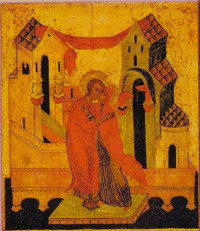|
|||
|---|---|---|---|
| This weekly bulletin insert complements the curriculum published by the Department of Christian Education of the Orthodox Church in America. This and many other Christian Education resources are available at http://dce.oca.org. | |||

The Orthodox Church celebrates a feast called, in its full formal title, The Conception by Righteous St. Anna of the Theotokos. The festal icon shows Anna and her husband Joachim in a loving conjugal embrace. This feast reveals one of the major differences between the teachings of the Orthodox Church and those of the Roman Catholic Church. In the Roman Church, the conception of Mary the Theotokos is called the Immaculate Conception. (Some people are not aware that this term refers to her conception rather than the conception of Jesus Christ.) The Roman Church teaches that Mary's conception was different from that of every other human being. Unlike the rest of us, she was born, through the intervention of God, without the stain of the Original Sin of Adam, which taints every human birth and which is transmitted through the act of sexual intercourse. The Orthodox Church's teaching is that Mary was born just as the rest of us are; she is a human being and her conception was the same as ours. In Orthodox teaching we human beings do not bear guilt for a sin committed "in Adam." Nor is there any "stain" associated with the act of sexual intercourse which was, after all, created by God as the way for children to be born from the union of a man and a woman. But Mary was a person with a special destiny, whose upbringing prepared her for a great place in God's plan. Her aged, childless parents had longed for a baby for many years. They prayed fervently, and Mary's conception was God's answer. As Father Thomas Hopko has written in his book "The Winter Pascha", "Mary is conceived in fulfillment of her parents' prayers in order to be formed in the womb, born on the earth, dedicated to the Lord, and nurtured in holiness to become by God's grace the mother of His Son the Messiah."
The combination of Mary's unique destiny and her normal conception as a "mere human being" means a great deal for our lives. We can look to Mary as the model of Christian life, and it's a model to which we can actually aspire, since she is not separated from us by having a conception and birth totally unlike ours. Yet her pure life and obedience to God, and her resulting closeness to Christ, make her an intercessor like no other. As some of our prayers put it, "the entreaty of a mother has great power to win the favor of the Master." In fact, the word "immaculate" is sometimes used to describe the purity and loving obedience to the Lord that characterized the Theotokos' life. But this word should not be misunderstood as referring to her conception. In the Theotokos we have a woman born like us, yet able to be a mother to the whole Church. The prayers of the feast invite us to share the joy of Joachim and Anna in Mary's conception, "for she is the fruit of the grace of God." |
|||
